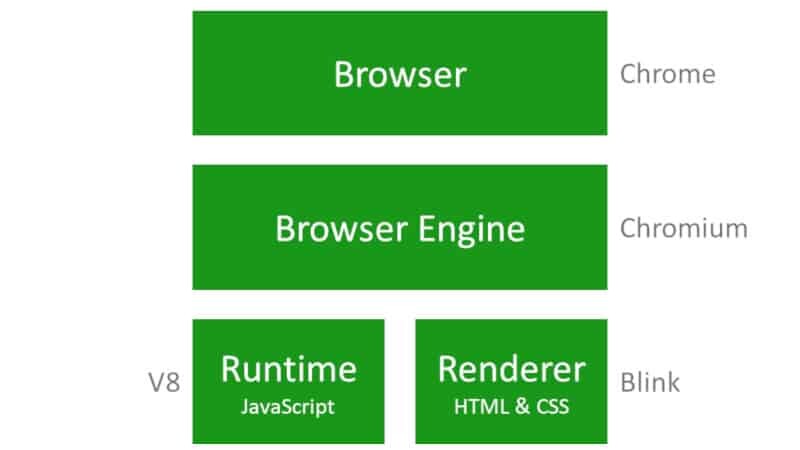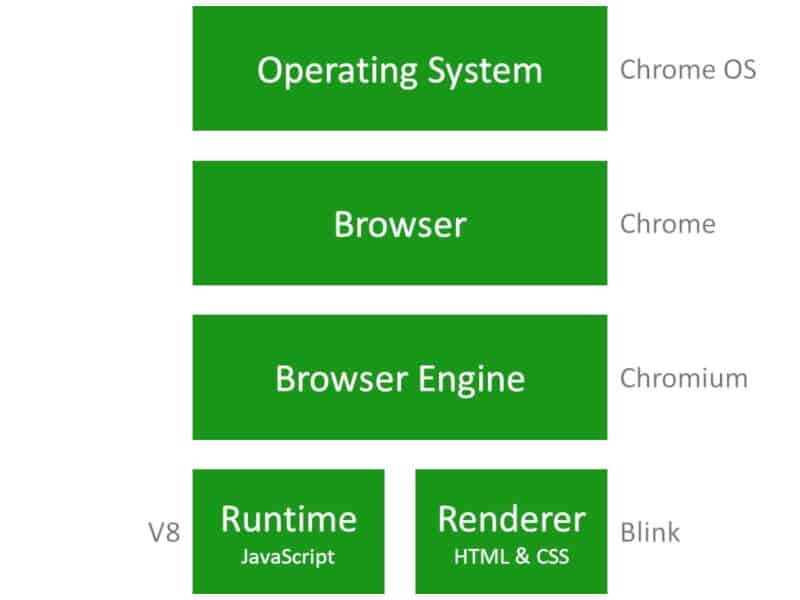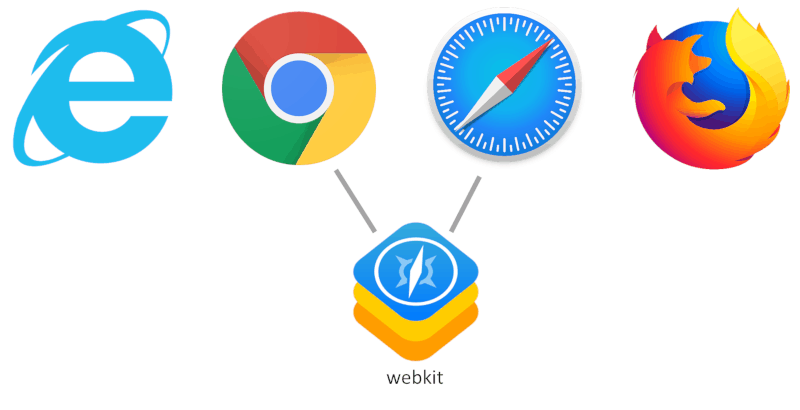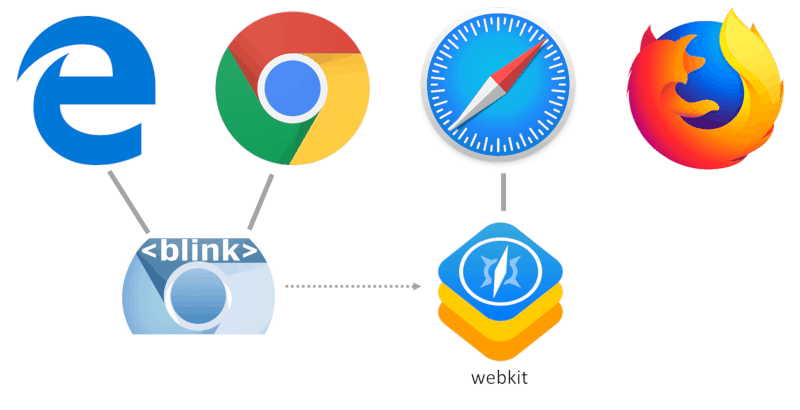Chrome=The web. Is that a good thing or a bad thing? Will Chrome Browser Engine dominate?

I’ve always said that Chrome is almost the only browser we need. Microsoft Edge was always an easy target to mock. And it now seems that Microsoft has thrown the towel on Edge and its technology stack as a differentiating factor and has decided to *gasp* use Chromium as the engine powering whatever comes next.
A long explanation from Microsoft on the move was published on github (more on GitHub later).
You can also learn more about WebRTC browser support on desktop and mobile.
What are Browsers made of?
I’ll start with a quick explanation of how I see a browser’s architecture. It is going to be rather simplistic and probably somewhat far from the truth, but it will be good enough for us for now.

A browser is built out of two main pieces: the renderer and the runtime engine.
The Renderer deals with displaying HTML pages with their CSS styling. Today, it probably also deals with CSS animation. It is what takes your webpage and renders it into something that can be displayed on the screen.
The Runtime Engine was all about executing JavaScript code inside the browser. It is what makes it interactive in modern browsers. It is usually called JavaScript Engine, but it is already running also WebAssembly, hence my preference in referring it as Runtime.
On top these two pieces sits the browser engine itself, which is later wrapped by the browser.
Who Uses What?
That illustration of the browser makeup above? It shows in gray the components that Google uses in Chrome. Each browser vendor picks and chooses its own components.
In the past, we effectively had 3 browsers engines: “Firefox”, “Internet Explorer” and “WebKit”
WebKit was used by both Safari and Chrome. That until 2013 when Google decided to part ways and create Blink – it started by deleting everything it didn’t use out of WebKit and continue from there. In a way, it is a fork of WebKit, to the point that code integrated into WebKit oftentimes comes directly by porting it enmasse from Blink/Chromium (this is how WebRTC is implemented in Safari/WebKit today).
Up until a year ago, we had 4 roughly independent browser engines for the major 4 browsers:
- Chrome, using Chromium, Blink and V8
- Firefox, using its own tech stack; with Gecko as the rendered, being replaced by Servo
- Safari uses WebKit and Nitro
- Edge had its own stuff – EdgeHTML and Chakra; now migrating to Chromium tech (and maybe a rebranded name instead of Edge?)
Internet Explorer is all but dead.
Edge was never getting useful market share and now moving to embrace Chromium.
Apple’s Safari… I am not sure how much Apple cares about Safari, and besides, WebKit gets its fare share of code from Google’s Blink project. On top of it all, it runs only on Apple devices, limiting its popularity and use.
In a way, we’re down to two main browser stacks: Google’s and Mozilla’s
Mozilla wrote about the end of the line for EdgeHTML and they are spot on:
If one product like Chromium has enough market share, then it becomes easier for web developers and businesses to decide not to worry if their services and sites work with anything other than Chromium. That’s what happened when Microsoft had a monopoly on browsers in the early 2000s before Firefox was released. And it could happen again.
I’ve tried Firefox and Edge a year or two ago. They worked well enough. But somehow they weren’t Chrome (possibly because I am a heavy user of Google services), so it just made no sense to stick with any of them when Chrome feels too much like “home”.
Is the current state of affair lifts Chromium to the status of Linux? More on that a bit later down this article.
Chrome Browser Engine: Chrome’s Dominance
I’ve taken a snapshot of StatCounter’s desktop browsers market share:

If you are more interested in the numbers than that boring visual line, then here you go:

Chrome with over 72%; IE and Safari at 5%; Edge at 4%.
Firefox has a single digit 9%.
Funnily enough, all non-Chrome browsers are trending downwards. Even Safari which should enjoy growth due to an increase of Mac machines out there (for some unknown reason they are popular with developers these days – go figure).
Even if you ignore the desktop and check mobile only (see here), Chrome gets some 53% versus Safari’s 22%.

Investing in browser development isn’t a simple task. There are several vectors that need to be pursued at all times:
- Adherence to the HTML5 specification(s), adding new components to it along the way (PWA, WebGL, WebVR, WebAssembly, Web Workers to name a few)
- Deal with backward compatibility of the billions of web pages that are out there as much as possible
- Handle security aspects
- Deal with performance and bloat
- Support hardware acceleration for optimized performance where possible, a trend that is becoming common
It would be safe to say that Chrome enjoys 100’s of Google employees developing code that goes directly into their Chrome browser engine.
Where will Microsoft take Edge?
Microsoft under the lead of CEO Satya Nadella has shifted towards the cloud and is doubling down on the enterprise. To a big extent, its XBox business is an anomaly in the Microsoft of 2018.
Where once Microsoft was all about Windows and the Office suite, it has shifted towards Office 365 (subscription versus licensing business model for Office) and its Azure cloud. Windows is still there, but its importance and market dominance are a far cry from where it was a decade ago. Microsoft knows that and is making the necessary changes – not to win back the operating system market, but rather to grow its businesses on other core competencies and assets.
Microsoft Edge was an attempt to shed Internet Explorer. Give its browser a complete rewrite and bring something users would enjoy using. That hasn’t turned well. After all the investment in Edge, it had a small market share to show for it, with many of the users switching to Windows 10 opting to switch to Chrome instead of Edge.
This user behavior is surprising to say the least. With a default browser that is good enough (Edge), why would they make the conscious decision of browsing to chrome.com to download and install a different browser that does what Edge does?
Microsoft tried and failed to change this user behavior, which led it to the conclusion that Edge, or at least the innards of Edge are a waste of resources.
Why does opting for Chromium as a browser engine make sense for Microsoft?
As Microsoft is shifting to the cloud, and Edge focusing on web standards, the end result was that anything and everything that Microsoft invested in for its web based services (Office 365 for example) has to work first and foremost on Chrome – that’s where users are anyway.
Google is using Chrome to drive proprietary initiatives to optimize its services for users and push them as standards later (think SPDY turn HTTP/2, QUIC or its latest Project Stream). It can do it due to its market dominance in browsers and the huge amount of web assets they operate. Microsoft never had that with Edge, so any proprietary initiatives on Microsoft’s part in web technologies was bound to fail.
Microsoft derived no value out of maintaining its own browser technology stack, and investing 100’s of developers on it was an expensive and useless endeavor.
So it went with Chromium.
Chromium brings one more benefit – theoretically, Microsoft can now push its browser to non-Windows 10 devices. Mac and Linux included. And since Microsoft is interested more in Office and Azure than it is in Windows, having an optimized “window” towards Office and Azure in the form of a Chromium-based Microsoft browser that works everywhere made sense.
This also means where Microsoft does want to focus its efforts in the browser – the user interface and experience, as well as in delivering the Microsoft services to customers.
Microsoft cannot forgo having its own browser and just pre-installing Chrome or even Firefox on its Windows operating system. That would mean ceding to much control to others. It has to have its own browser.
Windows Chromiumized
Remember that browser architecture I shared in the beginning? It is changing in one critical way. Google decided to create an “operating system” and call it Chrome OS, which ends up being based to some extent on the browser itself:

We spend more time in front of web applications that reside in the browser (or in Electron apps) and less inside native apps. This means that in many ways, the browser is the operating system.
Google derives all of its value from the internet, with the browser being the window there.
Microsoft is heading in the same direction, and where it matters for it with its operating system, it finds itself now competing against Chrome OS and Chromebooks, making it a huge threat to Microsoft and Office.
And obviously, there’s a “lite” version of Windows in the works, at least by the reports on Petri. Is this related to Edge using Chromium in some way? Would Windows Lite be web focused in the same way that Chrome OS is?
Who Controls Chromium? And is it the new Linux?
Back to Chromium, and the reasons that the Microsoft news is making ripples in the web around openness and positive fragmentation.
Browsers are becoming operating systems in many ways. Can we correlate between Linux and its ecosystem to Chromium and its growing ecosystem?
Linux and Ownership
I’d say that these are two distinctly different cases. If anything, Chromium’s status should worry many out there. It is less about monocultures, openness and high words and more about control and competitive advantage.
On opensource.com, Greg Kroah-Hartman Feed wrote two years ago a piece titled 9 lessons from 25 years of Linux kernel development. Here’s lesson 6:
6. Corporate participation in the process is crucial, but no single company dominates kernel development.
Some 5,062 individual developers representing nearly 500 corporations have contributed to the Linux kernel since the 3.18 release in December of 2014. The majority of developers are paid for their work—and the changes they make serve the companies they work for. But, although any company can improve the kernel for its specific needs, no company can drive development in directions that hurt the others or restrict what the kernel can do.
This is important.
Who really controls Linux? Who owns it? Who decides what comes next? The fact that there are no clear answers to these questions is what makes Linux so powerful and so useful to the industry as a whole.
Chromium and Google
Does the same apply to Chromium?
Chromium is a Google owned project. Hosted on a Google domain. Managed using Google tooling. Maintained by Google. This includes all the main browser pieces that are created, controlled and owned by Google to a large extent: the V8 JavaScript Engine, Blink web renderer and Chromium itself.
When someone wants to contribute into Chromium, they need to go through a rigorous process. One that takes place at Google’s leisure and based on their priorities. This is understandable. Chromium is what Chrome is made up of, and Chrome gets released to a billion users every 6-8 weeks. Breakage there ends with backlash. Security holes there means vulnerability at a large scale.
While these aspects of stability and security are there with Linux as well, when it comes to Chromium, Google is the one that is setting the priorities.
It doesn’t end with priorities. It goes to the types of web experiments and proprietary features that end up in Chrome. Since Google controls and owns the Chromium stack… it can do as it pleases.
Will Google cede control of Chromium just because?
No.
It might benefit the open-whatever if it did, but it would also slow down innovation and won’t further Google’s own cause.
Microsoft and Chromium
Microsoft is painting this in colors of open source and collaboration with the industry.
It isn’t.
This is about Microsoft going with Chromium because Edge took a few bad turns in its strategy from the get go:
- Limiting Edge to Windows 10 only
- Internet Explorer was always a Windows play, ignoring its stint on Mac
- Microsoft today is in a very different place – access to its services across all devices is what is driving it
- This requires its browser to run everywhere and not be limited to Windows 10
- Making Edge all about performance and security
- When Chrome was released, its leading pitch was exactly that. A secure browser with high performance
- As it grew in adoption, all browsers focused more resources towards that goal, and today, it is a moot point
- While Chrome is definitely a memory and resource hog, there’s no big backlash due to it
- Trying to take that same strategy as a differentiating point failed
- Not differentiating Edge through Microsoft’s assets
- There’s a challenge in this one. Take Office 365. If you make it run better on Edge and purposefully harming it on Chrome, you lose on (1) – you limit it on non-Windows devices
- Microsoft should have invested in a world where the user’s profile and preferences are stored in the cloud. Google and Apple devices “just work” when you plugin them in with your credentials. Microsoft doesn’t really
- Having a user’s profile in the cloud, easily accessible via Edge would strengthen the tie between people using Office and Azure to an Edge browser, keeping them away from Chrome
Going with Chromium means two things to Microsoft:
- Working on making Chromium (and by extension the new Edge) work perfectly on Windows devices (not only Windows 10, but also Windows 7, HoloLens and whatever comes next in the Internet of Things). This is an optimization effort, simply shifting it from what was Edge towards Chromium
- Doubling down on the differentiation of Edge based on a single browser engine, which is where it should have focused in the first place anyway. This means collecting all digital life assets Microsoft has on you within the business – Office, Teams, etc; and integrating them into the Edge experience in a way that people who use Microsoft services are compelled to do so from the Edge browser
The only challenge here is that it comes to Chromium as just another vendor. Not a partner or an owner.
A Single WebRTC Stack
At the recent Kranky Geek event, Microsoft discussed its WebRTC on UWP project. Part of it was about merging changes it made to the WebRTC code from webrtc.org (=the code that goes into Chrome). Here’s how James Cadd framed it in his session:
… after 4 years of maintaining a fork on github, we’ve been discussing with Google the possibility of submitting this back to the webrtc.org repo and we’re working on that now. The caveat is that there’s no guarantee that we’ll get 100% of the way there. We’re mostly using the public submission process, so we’re going through reviews just like everyone does, but that’s our goal.
The UWP specific changes are going to live in sdk-contrib-windows so we will have our own little area to contribute this back. Microsoft has comitter rights there, so we’ll be able to keep everything moving there. […]
So just wanted to say thank you to Google for that opportunity. We’re looking forward for the collaboration.
A master and a slave? A landlord and a tenant? A patron and a client? Two partners? I am not sure what the exact relation here is, but it should be similar to what Microsoft has probably struck with Google across the board for all Chromium related technologies that are dear to Microsoft in one way or another.
Is a single stack good or bad?
If we look at it from a browser level perspective, we aren’t in a different position in the technology diversity than 8 years ago:

And here’s where we are today:

The main difference is market share – Chrome is eating up the internet with Blink and Chromium. Factor in Node.js which uses V8 JavaScript engine and you get the same tech running servers as well.
WebRTC specific though? Now runs on webrtc.org code only. All browser vendors pick bits and pieces from it for their own implementations, and while they are differences between browsers they aren’t many.
As I said before in many of my articles here – most developers today can simply develop their code for Chrome and be done with it; adding support for more browsers only if they really really really need to.
Browsers are one piece of getting WebRTC to run. Check out what else you’ll need in this free video series unraveling the server side story of WebRTC:
Could Microsoft Buy Their way into Browser Market Share?
Not really. If they could have, they would done so instead of going Chromium.
Let’s start from why such a move would be appealing.
GitHub
The recent acquisition of GitHub by Microsoft can be taken as a case point. Especially considering at the varied reactions it brought across the board.
6 months after that announcement, the sky haven’t fallen. Open source hasn’t been threatened or gobbled up by Microsoft. And Microsoft is even using GitHub for its own projects, and to announce its own initiatives – Edge using Chromium for example.
Time will tell, but my gut tells me that Microsoft’s acquisition of GitHub is as meaningful as Facebook’s acquisition of Whatsapp and Instagram. These made little sense at the time from a valuation standpoint, but no one is doubting these acquisitions today.
With GitHub, Microsoft is buying its way into open source. Not only as lip service, but also in understanding how open source works. By owning a large portion of the open source interactions, and being able to analyze them closely, Microsoft can tell where developers are headed and what they are after. Microsoft was always successful due to the developers using their platform (top notch tools for developers – always). GitHub allows them to continue with that in an open source world.
Then why not the browser market?
There were two assets that could be acquired here – Mozilla and Electron.
Electron
Electron is already developed and maintained by GitHub directly. Microsoft owns it already.
What advantages does Microsoft derive from Electron? None, assuming you remember that Electron runs on top of Chromium.
From a strategic standpoint, there’s no value in Electron for Microsoft. At the end of the day, Electron is a window to Chromium and to web applications.
Microsoft is using it for its own cross platform applications – Skype on Linux has been known to use Electron for several years now.
Owning Electron through GitHub doesn’t help Microsoft in its browser market share.
Mozilla
Mozilla would have been an interesting acquisition.
Similarly to GitHub, it would be acquiring the obvious open source vendor. The challenge here is twofold:
- Mozilla wouldn’t want to be acquired and would rather stay independent, as this is their stance and current market position. It may change, but resistance internally from Mozilla employees would rather be big
- Firefox market share is now a single digit and the trend isn’t a positive one
Furthermore, acquiring Firefox as a window to Microsoft’s services and assets in the cloud is exactly one of them things that Mozilla is fighting Google against. It would be counterproductive to go there.
—
Microsoft has no one to buy in order to improve its position and market share in browsers.
It could only continue to fight it out with Edge or partner. And it decided to partner with the goliath in the room (an elephant wouldn’t be visible enough).
Will Chrome Reign Supreme?
Yes.
Anyone thinks otherwise?

It makes perfect sense, and I completely agree with you.
Why throwing tones of money on product that no body wants? as you said, MS must have something of their own, so they’re using chrome engine.
I don’t think it will take us back to the ridicules situation we had with IE. chrome browser code is open, everyone are free to take the code, add improvements and release new products without any permission from google – that’s exactly what google did with webkit few years ago…
Can google make Chromium closed source if they decide to?
Not really.
But – it can shift critical components of it out of Chromium into Chrome
And it doesn’t really matter as its strength lies from the control it exerts on the Chromium codebase and not from the fact that the code is hidden from sight.
Just an FYI: a number of (mostly mobile) browsers use WebKit, so it’s not really an Apple-only thing as you seem to imply in this article.
Brad,
Thanks. Do note that in iOS, ALL browsers are forced to use Apple’s WebKit. Not a WebKit, but the Apple supplied one that is preintegrated into the operating system. So for all intent and purposes, they don’t really matter.
On the desktop, all browsers other than the leading 4 have low market share anyway, so they don’t matter either.
It’s Mozilla’s own fault anyway. They attempted to catch up way too late after they kept trying to copy Chrome bit by bit, stripping out everything that made Firefox what it actually was and making every single release less stable by every number increment while adding nothing but customisation removal (which is why they kept losing market share rapidly) – now, they’re going about priding about their ‘independence’ to pander to the communists who think they can actually make a difference when in reality, Mozilla should just give up the useless chase they caused on themselves.
In reality they should have just given up in 2008 and worked on Chromium… I honestly hope Firefox dies in a ditch at this point, the only people who actually care about privacy are doing seedy shit themselves.
????
This is somewhat too harsh. I thought hard if I wanted to approve it. Decided in the end I would. I definitely don’t think this way, even while using Chrome on a day to day basis.